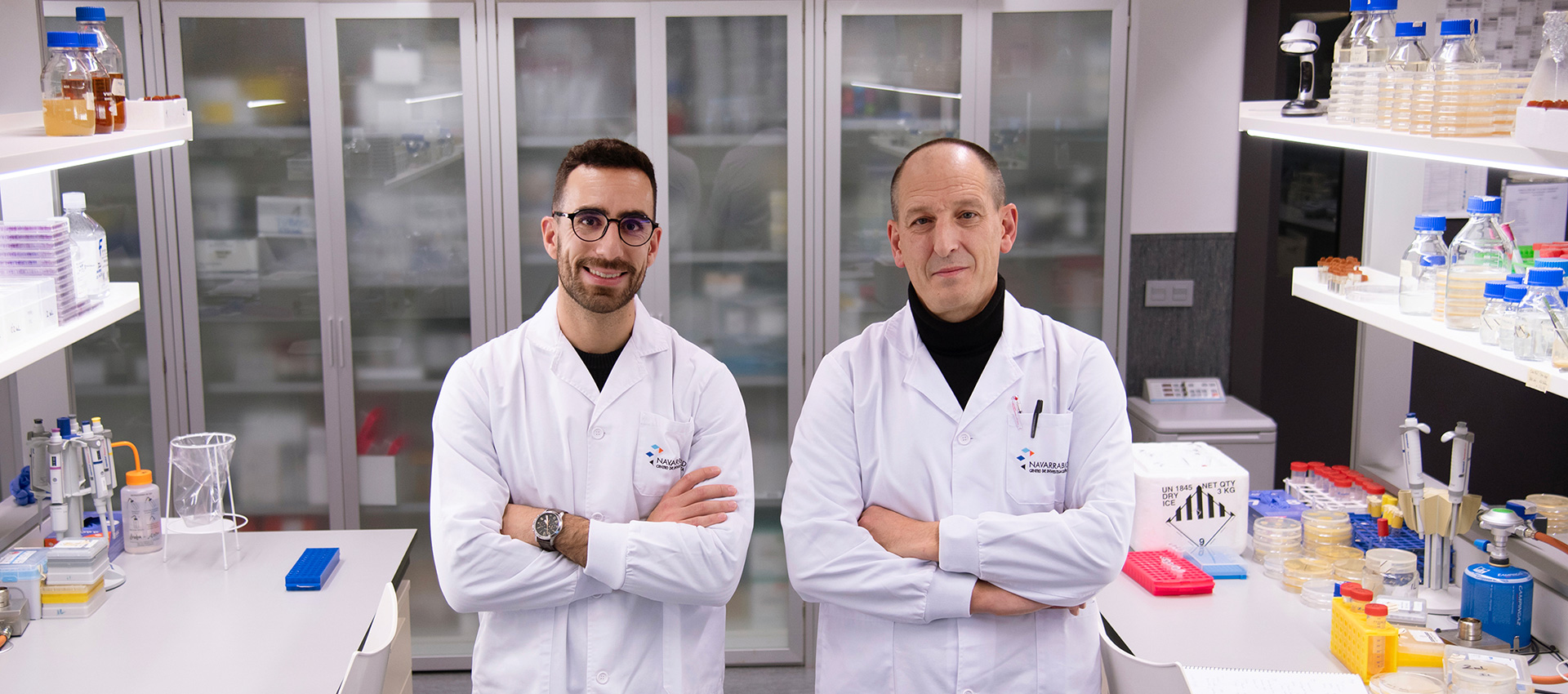
A genetic study reveals how viruses that infect bacteria, protect themselves and at the same time, safeguard their hosts
The biologist Pablo Iturbe is awarded a doctorate at UPNA with research published in the journal “Nature Microbiology” that opens avenues to develop strategies that allow the resistance of bacteria to destruction by viruses to be overcome
Research carried out at the Microbial Pathogenesis Unit at Navarrabiomed, a joint biomedical research centre of the Gobierno de Navarra and the Universidad Pública de Navarra (UPNA), has discovered the way in which the virus that infects the pathogenic bacteria Staphylococcus aureus organizes a type of gene in its genome to achieve a complex balance, namely to protect the bacteria and the host, from infection by other viruses, to prevent it from being destroyed (immunity) and to prevent this same defence mechanism from interfering with the activity of the virus and eliminating it (autoimmunity).
Given that there are strains of this bacteria that are multi-resistant to antibiotic treatment, a strategy to combat it consists in the use of phage therapy, which uses viruses, called phages, to infect and eliminate it. The understanding generated in this work may contribute to the development of strategies that allow us to overcome the resistance that bacteria present to destruction by viruses. This study, which is the result of the doctoral thesis defended at the UPNA by the biologist Pablo Iturbe Sanz (Madrid, 1994), has been published in the scientific journal “Nature Microbiology”.
According to Iturbe, S. aureus is a “tremendously versatile” pathogenic bacteria that is capable of producing very diverse infections ranging from pneumonia, abscesses, osteomyelitis (infection of the bone) or endocarditis (inflammation of the inner layer of the heart) to infections of all types of implants and prostheses. Furthermore, as there are strains that are multi-resistant to antibiotic treatment, the World Health Organization (WHO) has identified it as “one of the priority bacteria for the development of new antibiotics.”
S. aureus can be infected by specific viruses called bacteriophages, or phages, which attach to it. This relationship is considered to be parasitic as the phage takes advantage of the bacteria and uses its resources to reproduce. This can eventually lead to bacterial death when new phages are released and disrupt the bacterial cell.
However, some phages have the ability to protect the bacteria from infections by other viruses, which is known as immunity, in a kind of symbiotic relationship in which the phage and the bacteria coexist. This is beneficial for the resident phage, as it ensures that it has no competition for the bacteria's resources. For this coexistence to work, the system must be balanced in order to also allow the resident phage to survive (autoimmunity) without being eliminated by the bacteria's own defence mechanisms.
Defence mechanism against viruses
Iturbe’s research has shown that S. aureus uses the architecture of non-contiguous operons to ensure that the defence mechanism against other viruses is completely turned off and does not act against itself when the resident virus begins to multiply to colonize other bacteria. Operons are groups of genes that are found together in DNA, while in the case of non-contiguous operons, the genes are not located next to each other in the genome, but can be turned on or off together in response to certain signals or conditions, despite their physical separation. These genes perform fundamental roles in the biology of the bacteria and the virus.
This work, which has been carried out in collaboration with the research group of Professor José R. Penadés at Imperial College London (United Kingdom), arises from previous studies developed by the Microbial Pathogenesis Unit at Navarrabiomed, led by the UPNA professor Íñigo Lasa Uzcudun, which described the existence of a new transcription unit, known as the non-contiguous operon, was described.
In addition to being published in the journal “Nature Microbiology”, the results of the doctoral thesis have been collected in another scientific publication “microLife” and have been disseminated at the international microbiology conference The New Microbiology, organized by the European Molecular Biology Organisation.
Brief curriculum
Before being awarded his doctorate by the UPNA, Pablo Iturbe gained a degree in biology (specialising in biotechnology) at the Universidad Complutense de Madrid, where he participated in a research project in the Department of Genetics, in the Plant Biotechnology group, concerning the study of rice retrotransposons. Later, he completed a Master’s Degree in Integrative Cellular and Molecular Biology at the Universidad Menéndez Pelayo and worked for two years in the Environmental Microbiology group, collaborating in a European project focused on the revaluation of industrial waste compounds using genetically modified bacteria.
While studying for his doctoral thesis at the UPNA, which was carried out at Navarrabiomed under the supervision of Iñigo Lasa, Pablo Iturbe has received an FPI scholarship obtained through the 2017 call for grants for R&D&i projects from the Ministry of Economy, Industry and Competitiveness. The thesis forms part of the scientific activity of the Healthcare Research Institute of Navarra (IdiSNA).


